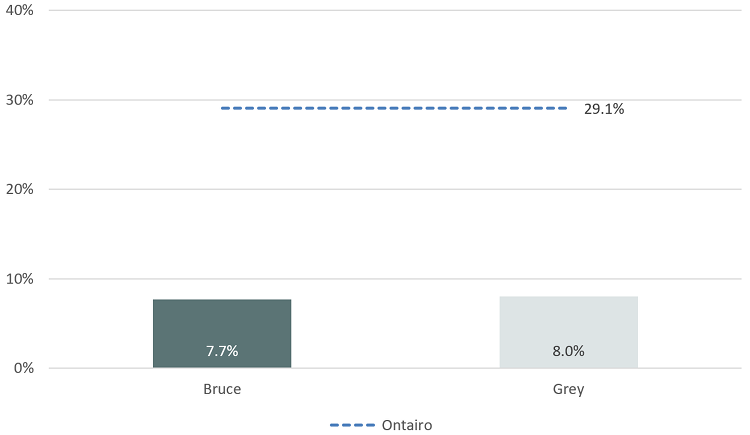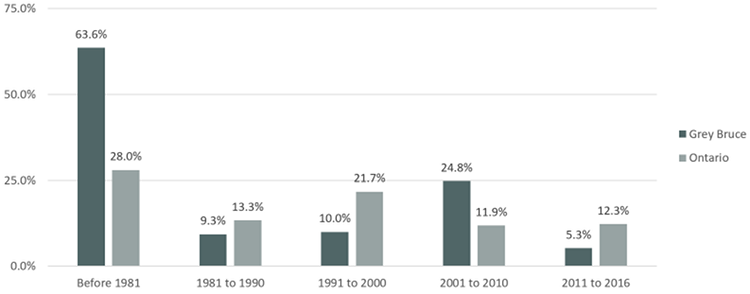Immigration and Ethnocultural Diversity
Immigrant Population
By Period of Immigration
By Birth Continent
Visible Minority Population
Immigrant Population
Canada’s immigrant population is defined as persons who are or have ever been landed immigrants in Canada. A landed immigrant is not a Canadian citizen by birth, but has been granted the right to live in Canada permanently by immigration authorities. A total of 12,495 Grey Bruce residents (7.9% of the population) reported that they were or had ever been a landed immigrant in 2016. Figure 1 displays the proportion of immigrants in Ontario, Bruce County, and Grey County in 2016. Immigrants made up 7.7% of the population in Bruce County and 8.0% in Grey County; much lower than the provincial proportion of 29.1%.
Figure 1. Proportion of the Population Who Are or Have Ever Been Landed Immigrants, Bruce County, Grey County and Ontario, 2016

Table 1 displays the number of people in each Grey Bruce municipality who are or have ever been landed immigrants or non-permanent residents, and the proportion of the population they represent within that municipality. Refugees, students, and those with work permits or Minister’s permits are not landed immigrants, but non-permanent residents. Non-permanent residents are persons from another country who have a work or study permit or who are refugee claimants, along with their family members sharing the same permit and living in Canada with them. Most Grey Bruce residents who are or have ever been landed immigrants live in Owen Sound, followed by Saugeen Shores, Kincardine, and Meaford.
Table 1. Immigration Status, Grey Bruce Municipalities, 2016
|
Geography (population in private households)
|
Non-immigrants* (%)
|
Immigrants (%)
|
Non-permanent residents (%)
|
|
Ontario (13,242,160)
|
9,188,815 (69.4)
|
3,852,145 (29.1)
|
201,200 (1.5)
|
|
Grey Bruce (158,455)
|
145,735 (92.0)
|
12,495 (7.9)
|
225 (0.1)
|
|
Bruce (66,715)
|
61,470 (92.1)
|
5,135 (7.7)
|
110 (0.2)
|
|
Arran-Elderslie (6,715)
|
6,370 (94.9)
|
320 (4.8)
|
25 (0.4)
|
|
Brockton (9,245)
|
8,870 (95.9)
|
375 (4.1)
|
-
|
|
Huron-Kinloss (6,870)
|
6,375 (92.8)
|
485 (7.1)
|
10 (0.1)
|
|
Kincardine (11,175)
|
9,840 (88.1)
|
1,310 (11.7)
|
25 (0.2)
|
|
N. Bruce Peninsula (3,845)
|
3,415 (88.9)
|
410 (10.7)
|
20 (0.5)
|
|
Saugeen Shores (13,425)
|
11,970 (89.1)
|
1,440 (10.7)
|
15 (0.1)
|
|
South Bruce (5,620)
|
5,440 (96.7)
|
180 (3.2)
|
-
|
|
S. Bruce Peninsula (8,190)
|
7,580 (92.7)
|
600 (7.3)
|
10 (0.1)
|
|
Grey (91,740)
|
84,265 (91.9)
|
7,360 (8.0)
|
115 (0.1)
|
|
The Blue Mountains (6,935)
|
6,105 (88.0)
|
815 (11.8)
|
15 (0.2)
|
|
Chatsworth (6,545)
|
6,030 (92.1)
|
505 (7.7)
|
10 (0.2)
|
|
Georgian Bluffs (10,430)
|
9,720 (93.2)
|
695 (6.7)
|
15 (0.1)
|
|
Grey Highlands (9,715)
|
8,975 (92.4)
|
715 (7.4)
|
25 (0.3)
|
|
Hanover (7,325)
|
6,930 (94.5)
|
395 (5.4)
|
-
|
|
Meaford (10,855)
|
9,700 (89.4)
|
1,145 (10.6)
|
10 (0.1)
|
|
Owen Sound (20,350)
|
18,830 (92.6)
|
1,485 (7.3)
|
35 (0.2)
|
|
Southgate (7,345)
|
6,710 (91.3)
|
635 (8.6)
|
-
|
|
West Grey (12,240)
|
11,265 (92.0)
|
960 (7.8)
|
15 (0.1)
|
*Non immigrant population = persons who are Canadian citizens by birth
Figure 2 displays the immigrant populations in Grey Bruce and Ontario by the period of time in which they immigrated. Most immigrants to Grey Bruce (63.6%) arrived prior to 1981, whereas only 28% of Ontarian immigrants arrived prior to 1981.
Figure 2. Immigrant Population by Period of Immigration, Grey Bruce & Ontario

Table 2 displays the top 3 birth continents of immigrants to Ontario, Bruce County, and Grey County. Most immigrants to Bruce and Grey Counties were born in Europe, primarily in the United Kingdom, Germany, and the Netherlands. This is followed in Bruce County by Asia and the Americas, and in Grey County by the Americas and Asia. The majority of immigrants to every municipality in Grey Bruce were born in the United Kingdom, except in Arran-Elderslie where most were born in the Netherlands, and Southgate where most were born in Mexico.
Table 2. Top 3 Birth Continents of Immigrants to Ontario, Bruce County, and Grey County, 2016
|
|
Ontario
|
Bruce County
|
Grey County
|
|
1
|
Asia (1,869,805)
|
Europe (3,555)
|
Europe (5,265)
|
|
2
|
Europe (1,144,300)
|
Asia (865)
|
Americas (1,170)
|
|
3
|
Americas (598,950)
|
Americas (600)
|
Asia (700)
|
Visible Minority Population
Table 3 displays the number and proportion of people in each Grey Bruce municipality who self-identify as a member of a visible minority group. The definition of visible minorities used by Statistics Canada defines visible minorities as “persons, other than Aboriginal peoples, who are non-Caucasian in race or non-white in colour”. The proportions of Grey Bruce residents who identify as a member of a visible minority group, at 2.7% in Bruce County and 2.1% in Grey County are much lower than the Ontario proportion of 29.3%. Most people in Grey Bruce and Ontario who identified as part of a visible minority group identified as South Asian, Black, or Chinese.
Table 3. People who Identify as a Member of a Visible Minority Group, Grey Bruce Municipalities, 2016
|
Geography (Population in private households)
|
Visible minority population (%)
|
|
Ontario (13,242,160)
|
3,885,585 (29.3%)
|
|
Grey Bruce (158,450)
|
3,705 (2.3%)
|
|
Bruce (66,720)
|
1,805 (2.7%)
|
|
Arran-Elderslie (6,715)
|
130 (1.9%)
|
|
Brockton (9,245)
|
125 (1.4%)
|
|
Huron-Kinloss (6,870)
|
75 (1.1%)
|
|
Kincardine (11,165)
|
625 (5.6%)
|
|
N. Bruce Peninsula (3,840)
|
65 (1.7%)
|
|
Saugeen Shores (13,430)
|
620 (4.6%)
|
|
South Bruce (5,620)
|
50 (0.9%)
|
|
S. Bruce Peninsula (8,185)
|
110 (1.3%)
|
|
Grey (91,730)
|
1,900 (2.1%)
|
|
Blue Mountains (6,935)
|
100 (1.4%)
|
|
Chatsworth (6,540)
|
90 (1.4%)
|
|
Georgian Bluffs (10,430)
|
130 (1.2%)
|
|
Grey Highlands (9,720)
|
100 (1.0%)
|
|
Hanover (7,330)
|
90 (1.2%)
|
|
Meaford (10,845)
|
255 (2.4%)
|
|
Owen Sound (20,345)
|
835 (4.1%)
|
|
Southgate (7,350)
|
115 (1.6%)
|
|
West Grey (12,240)
|
170 (1.4%)
|
Read the full report here: Census Release V Immigration, Ethnocultural Diversity, and Aboriginal Identity
Data specific to Neyaashiinigmiing and Saugeen First Nations are not included in this report due to high non-response rates (24.9% and 37.8% respectively)
Data in this release are based on the short-form census which samples 25% of the population. Statistics Canada calculates estimates for the entire population based on this sample.
To ensure confidentiality, the values, including totals, are randomly rounded either up or down to a multiple of '5' or '10.' To understand these data, you must be aware that each individual value is rounded. A value of zero (-) does not necessarily mean that there are no people in that particular category.
Source: Statistics Canada. 2017. Various Geographies. Census Profile - Age, Sex, Type of Dwelling, Families, Households, Marital Status, Language, Income, Immigration and Ethnocultural Diversity, Housing, and Aboriginal Peoples for Canada, Provinces and Territories, Census Divisions and Census Subdivisions. 2016 Census. Statistics Canada Catalogue no. 98-401-X2016054. Ottawa. Released October 25, 2017 http://www12.statcan.gc.ca/census-recensement/2016/dp-pd/prof/details/download-telecharger/comp/page_dl-tc.cfm?Lang=E (accessed October 30, 2017).
Definitions: Statistics Canada, 2016. Dictionary, Census of Population 2016. http://www12.statcan.gc.ca/census-recensement/2016/ref/dict/index-eng.cfm